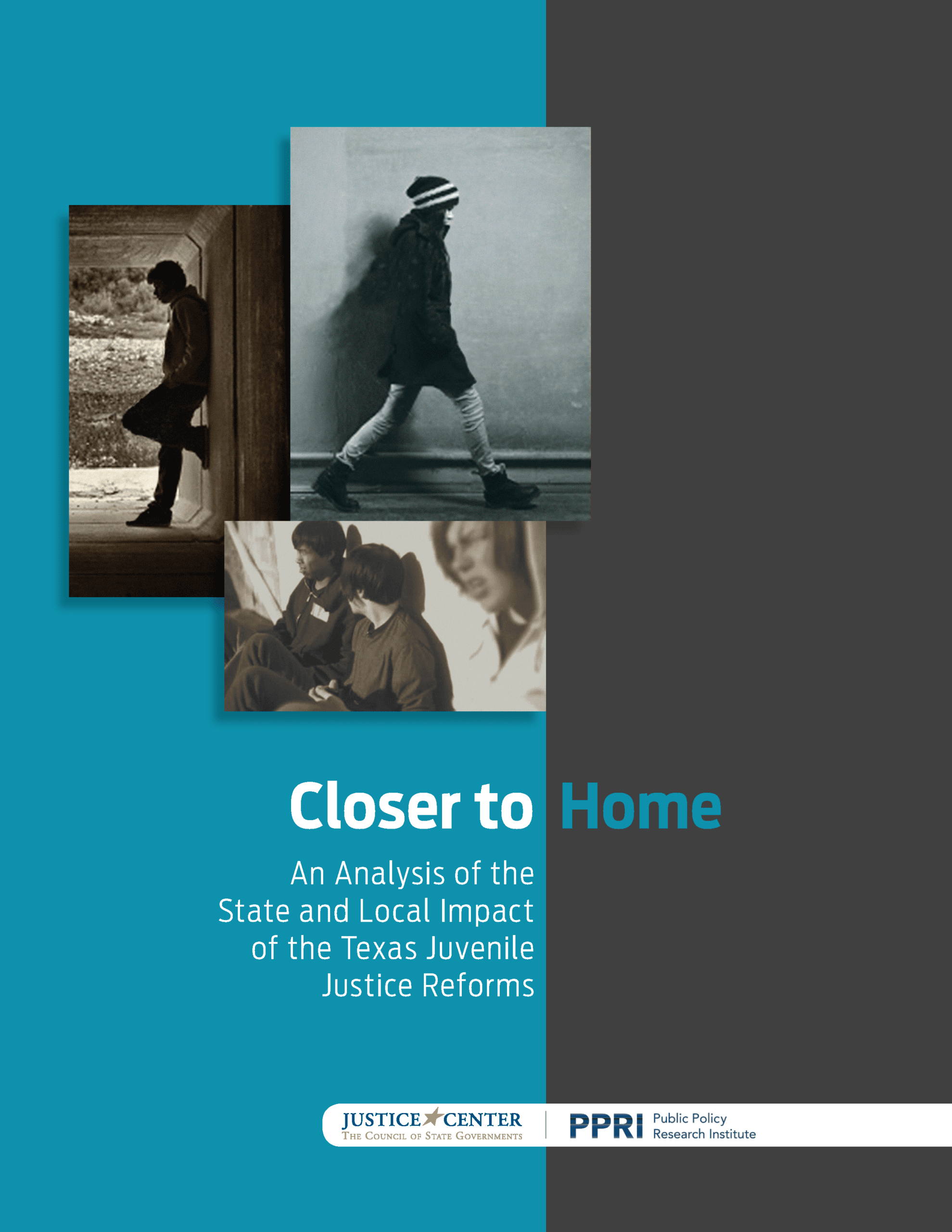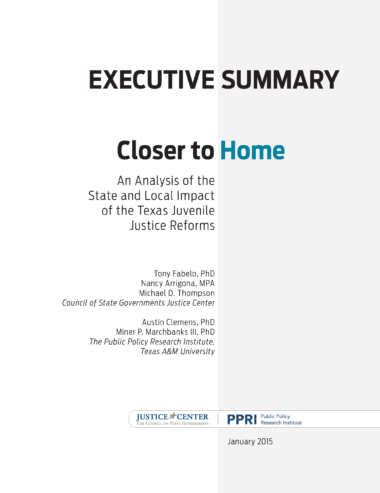Closer to Home: An Analysis of the State and Local Impact of the Texas Juvenile Justice Reforms
A first-of-its-kind study of Texas youth involved with the juvenile justice system shows that juveniles under community-based supervision are far less likely to reoffend than youth with very similar profiles who are confined in state correctional facilities.
Closer to Home: An Analysis of the State and Local Impact of the Texas Juvenile Justice Reforms, which draws on an unprecedented dataset of 1.3 million individual case records spanning eight years, shows youth incarcerated in state-run facilities are 21 percent more likely to be rearrested than those who remain under supervision closer to home. When they do reoffend, youth released from state-secure facilities are three times more likely to commit a felony than youth under community supervision.
The CSG Justice Center unveiled the report on Thursday, January 29, 2015, in a packed room of the Texas Supreme Court, alongside Tennessee Senate Majority Leader Mark Norris, who also serves as chair of CSG, Texas State Sen. John Whitmire, Texas Chief Justice Nathan Hecht, and a number of others.
“The extraordinary data compiled for this study demonstrates convincingly how much better youth—who prior to the reforms would have been incarcerated—fare instead under community supervision,” said Michael D. Thompson, director of the CSG Justice Center. “It also finds that for those youth placed under community supervision, there is still considerable room for improvement.”
The number of incarcerated youth has decreased by more than 40 percent across the nation—with some state populations declining by as much as 80 percent—since 2000, when the number of juveniles incarcerated was at a record high.in the U.S.
A positive school experience, where a child feels secure, is essential for their well-being. However, for many children…
Read MoreWhen returning to their communities from criminal justice settings, people with behavioral health needs face barriers in accessing…
Read More Supporting Children of Incarcerated Parents: Reimagining School and Community Collaboration
Supporting Children of Incarcerated Parents: Reimagining School and Community Collaboration
A positive school experience, where a child feels secure, is essential for their well-being. However, for many children with incarcerated parents—one in 14 in the U.S.—school can feel far from safe due to stigma, trauma, and a lack of understanding.
Read More Assigned to the Cloud Crew: The National Incarceration Association’s Hybrid Case Management for People with Behavioral Health Needs
Assigned to the Cloud Crew: The National Incarceration Association’s Hybrid Case Management for People with Behavioral Health Needs
When returning to their communities from criminal justice settings, people with behavioral health needs face barriers in accessing basic needs—including food, housing, employment, transportation, education, clothing, and substance use and mental health services—which increases their risk of experiencing a crisis.
Read More Meet the Medicaid and Corrections Policy Academy Mentor States
Meet the Medicaid and Corrections Policy Academy Mentor States
New Hampshire Department of Corrections Commissioner Helen Hanks presents at the Medicaid and Corrections Policy Academy in-person meeting.
Read More Taking the HEAT Out of Campus Crises: A Proactive Approach to College Safety
Taking the HEAT Out of Campus Crises: A Proactive Approach to College Safety
The sharp rise in school shootings over the past 25 years has led school officials across the U.S. to take a closer look at ways to keep students safe. For Chaffey College in Rancho Cucamonga, California, a tragic incident at a nearby university hit close to home and spurred campus leaders to revisit their own school’s threat assessments and crisis responses.
Read More New Smart Supervision Resident Analyst Program to Increase Supervision Agencies’ Data Analysis Capacity
New Smart Supervision Resident Analyst Program to Increase Supervision Agencies’ Data Analysis Capacity
Ideally, leaders would have actionable data readily available to them when they need it most. However, many agencies encounter significant challenges related to procuring accurate, consistent, and timely data, often grappling with outdated systems and inadequate tools.
Read More












